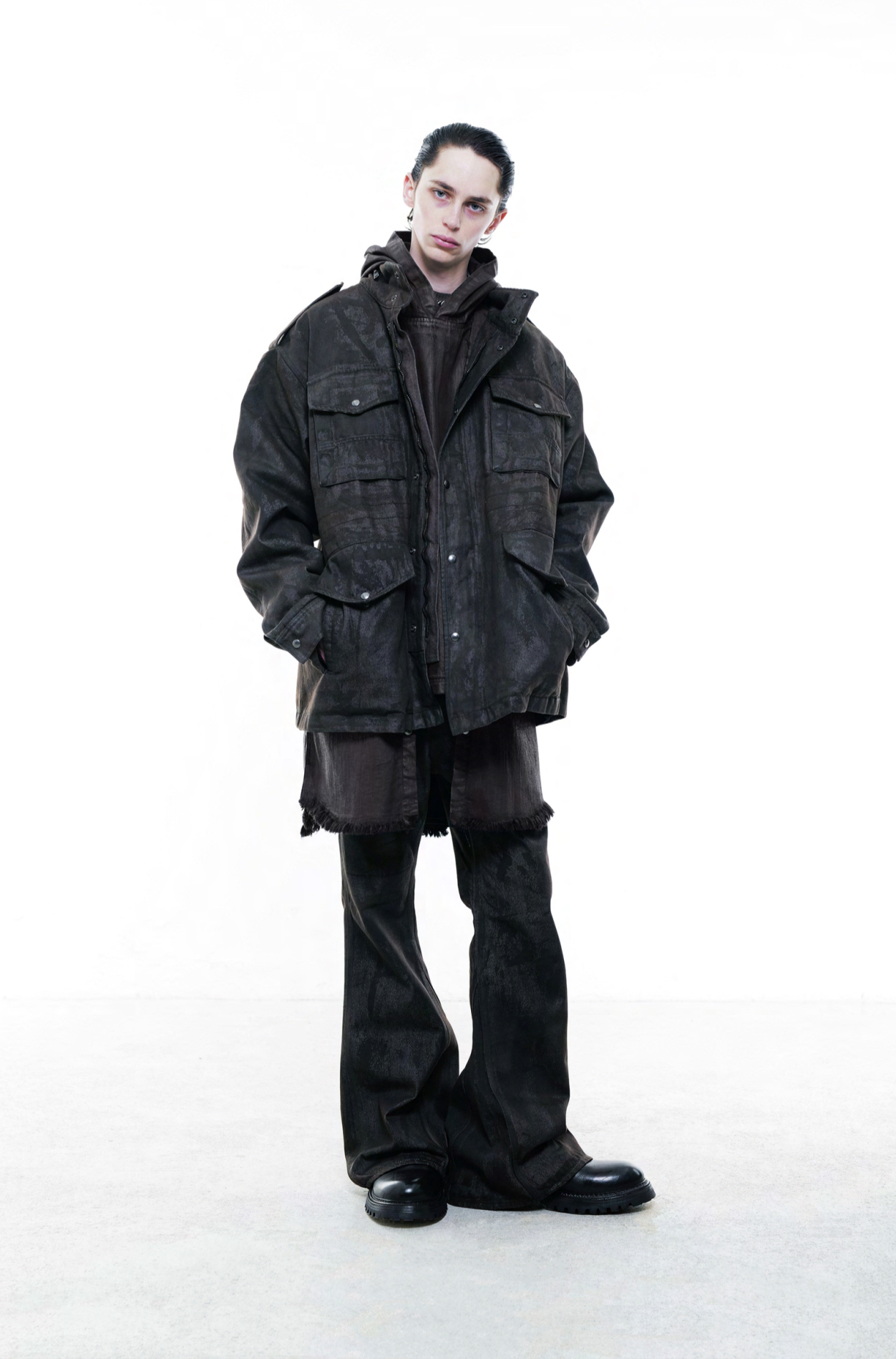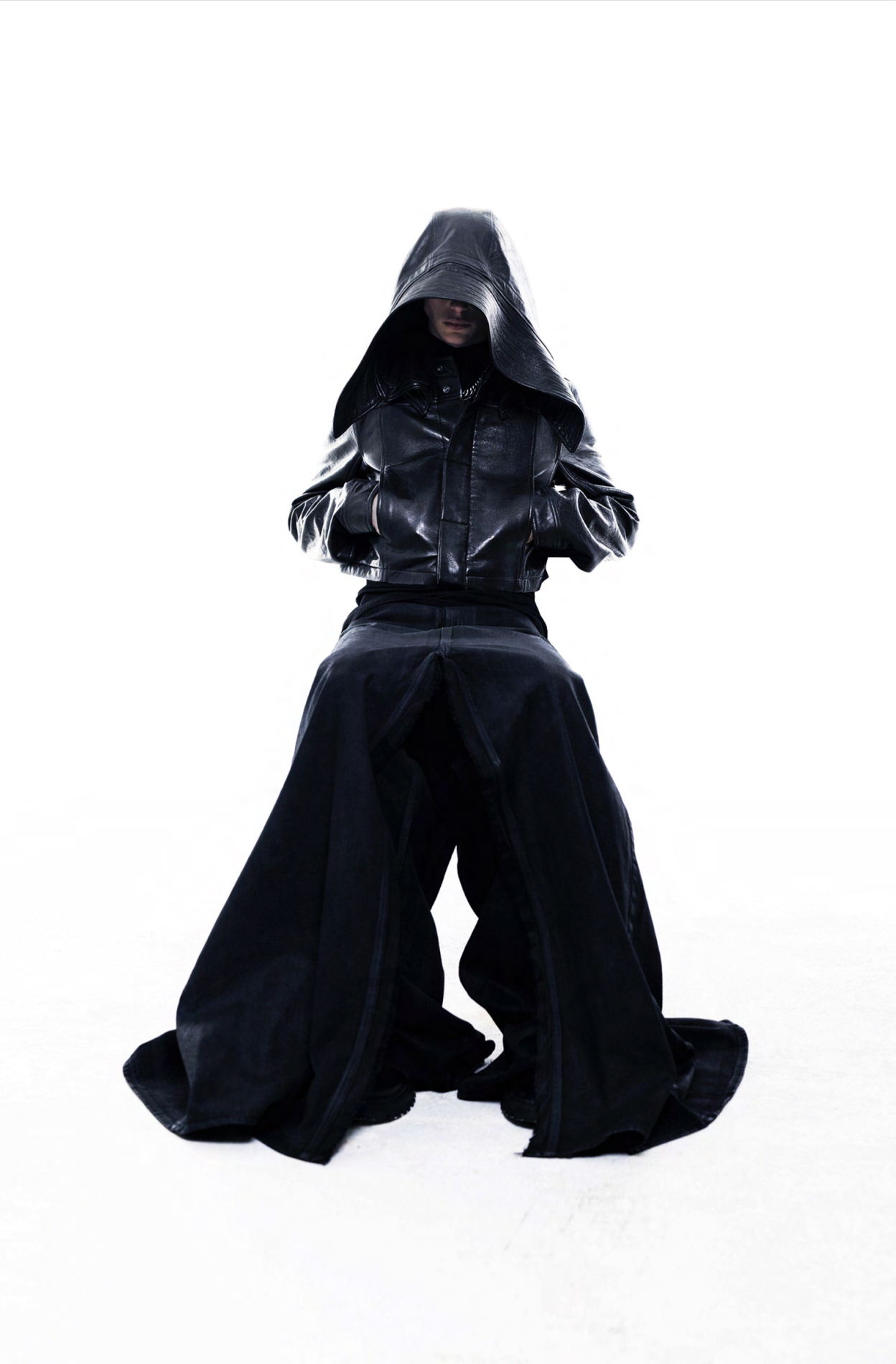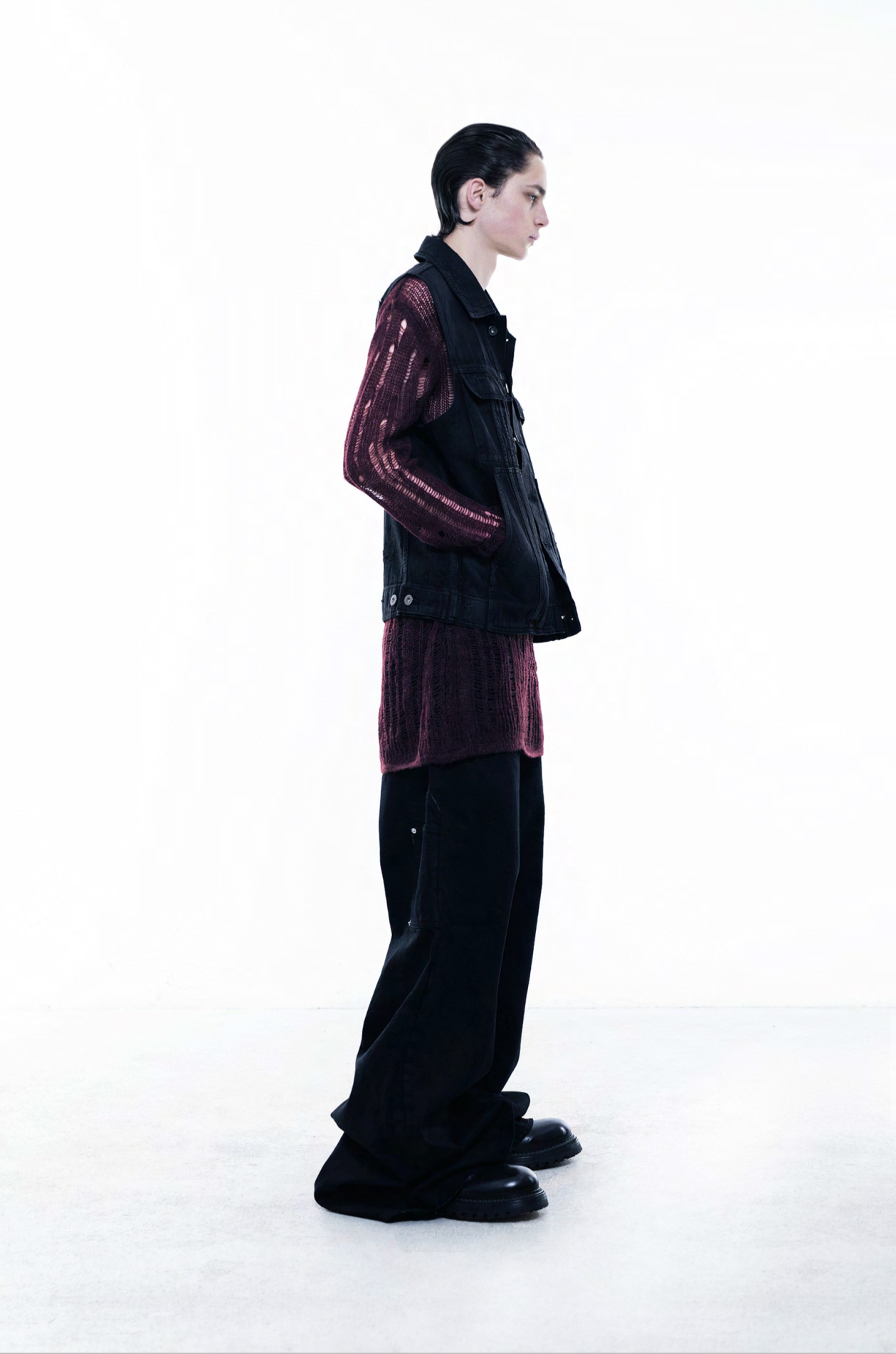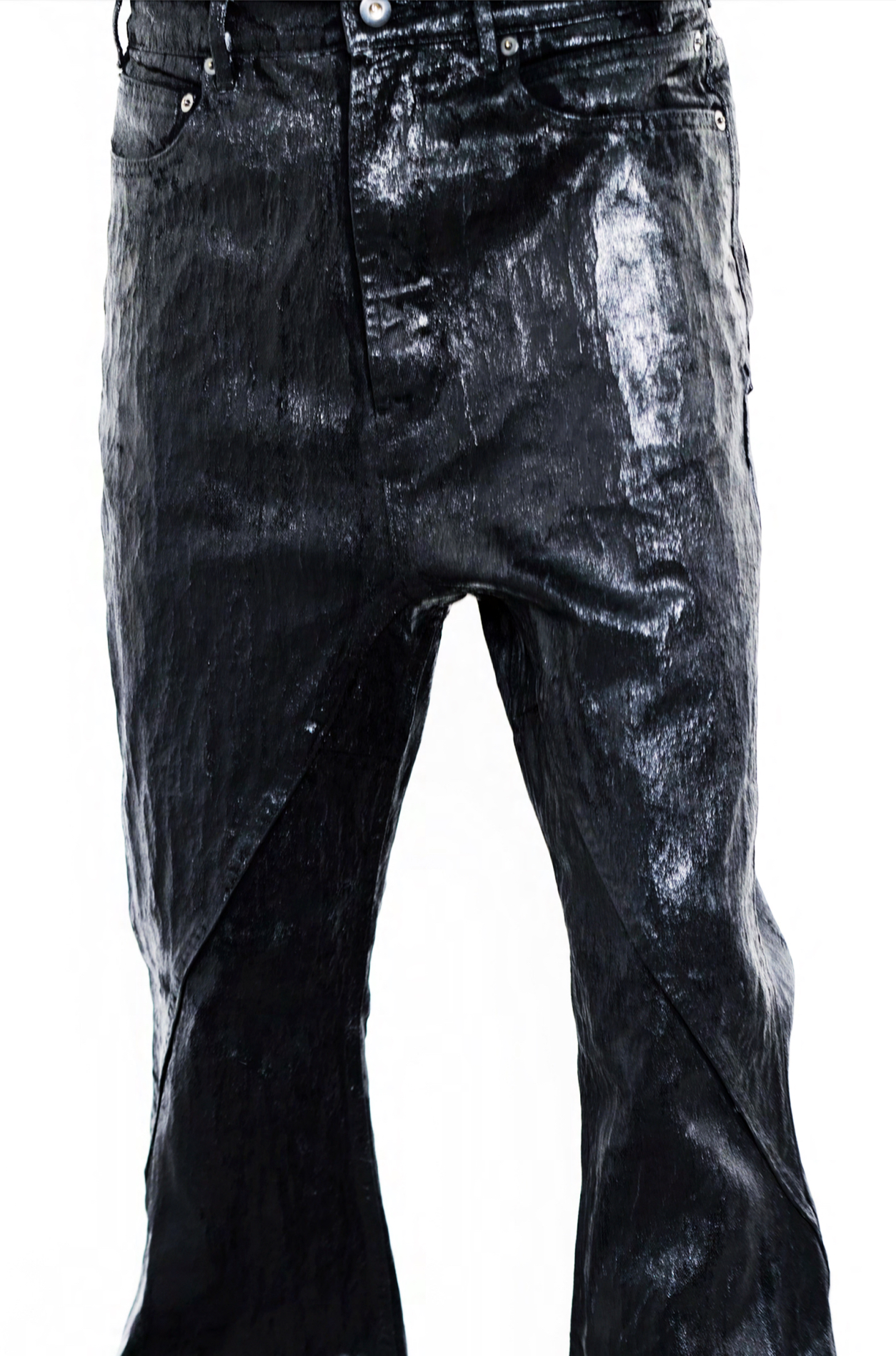Beyond the usual fashion experiment in deconstruction, Det Blev Sent’s Fall/Winter 2025 lineup, takes an almost scientific approach to its sartorial mission. Founded in February 2023 by a creative director who prefers to remain anonymous, the New York-based brand returned with Fracture, a collection set on interrogating ideas of perception, time, and the fundamental instability of “meaning” itself.
This New York Fashion Week season, the brand grounded its hypothesis in Scottish artist Douglas Gordon’s 24 Hour Psycho (1993); a video installation which slowed Alfred Hitchcock’s thriller, Psycho (1960), to a full-day runtime using VCR technology. Just as Gordon applied extreme deceleration to open up “unseen and unknowable space” in Hitchcock’s classical psychological horror, Det Blev Sent (DBS) sought to pull garments apart “piece by piece, then put them back together with the detail of a forensic scientist.” Quoting Gordon himself, a released statement for the collection located its ethos in the desire to “find the truth in something.” “This is a classical way to deconstruct a narrative,” Gordon said, “…you have to acknowledge your own forgetfulness.”

Indeed, DBS’s FW25 lookbook bears the look of a forensic laboratory and a colour palette steeped in cinematic unease. From inside this image, DBS FW25 showcases the brand’s obsession with the mutability of form, resting the idea of Fracture upon the intersection of fashion as fixed and fashion as flux.
Picture garments bleached, re-dyed, and coated with wax. As each stage of creation layered each garment with meaning, they evolved, as did their meanings. Over-dyeing revealed new colours emerging over time. Pieces enhanced with mixes of paint and wax bloomed with new, dark layers of colour in the fabric; the bomber jacket and trousers featured wax mixed with a thick paste that cracked and naturally bled off with time. The collection carries a relishing sense of the discomfort of making and unmaking, breaking and mending. This understanding most vividly strikes through the reassemblage of the DBS signature hooded leather and bomber jackets, which were similarly deconstructed into repetitive components and reoriented into new garments through patchwork. All the clothing presents itself as some dismantled, other-thing, reimagined, always on the verge of something else.

In this way of deconstruction and recombination, the pieces evolve, compelling the DBS wearer to reconsider not only the material identity of clothing but also its narrative function. The collection asks: if the collar of a bomber jacket is grafted onto the body of a denim jacket, what does it become? Is it still a bomber jacket, or a denim jacket? On some level, the collection asks these questions of taxonomy. Upon (or beneath) another layer, the questions become provocations about how we ascribe meaning to the clothes we wear, and further, how human history and cultural memory shape our understanding of not just fashion, but material existence too.
This interrogation of perception extends to the collection’s relationship with time. Much like Douglas Gordon’s 24-Hour Psycho, which distorts a familiar narrative by slowing it to an almost imperceptible crawl, Fracture applies regression, erosion, and over-layering to disrupt the way we read clothing. Rejecting popular fashion’s fetish for linearity in the rigid timelines through which it operates—the categories of ‘in’ versus ‘out’, the ‘fresh’ versus the ‘obsolete’—Fracture’s commitment to bleaching, re-dyeing, and wax treatments that crack with wear, builds into the garments a resistance to permanence. As they progress over time, the garments undergo a real-time transformation, actively decaying—not in a biological sense, but by constantly, subtly shifting in both the nature and appearance of the fabric and the garment entirely.

With every use, each garment demands consideration, much like how Gordon’s work forced viewers to reprocess Hitchcock’s Psycho, frame by infinitesimal frame. Here, the collection arrives at a deliberate ambiguity, an ever-slight refusal to allow any single, definitive reading of itself.
Colour, too, becomes a medium for narrative disruption in DBS FW25. From Psycho and Gordon’s reinterpretation of the film, Fracture pulls its warm blacks, browns and burgundies. In the silvery grays, Fracture evokes unease in the aesthetic energy of heavy metal and pure phosphorous rock. Colour affects psychologically too; as appearance and texture shift in the light, their tones imbue the garments with a layered, almost spectral quality. Nothing remains as you remember it, and memory too, like colour, exposes its instability and vulnerability to distortion.

But if DBS’s Fracture works as an active study of deconstruction, it also serves as an implicit meditation on labour and process. In its poetic texture, which develops through the process of colours revealing themselves, cracked waxes, bleeding dyes and controlled decay, the clothes in this collection refuse to adhere to the illusion of garment-making as an arbitrary miracle. One does not need to look too closely to see that the clothes carry traces and proofs of their time in the maker’s hands. From patchwork leather pieces to assemblages from discarded remnants, the collection challenges ideas of how value is added to clothes, what is deemed worthy of preservation, and what is relegated to waste.
Where the repetition is visible in these garments, the collection speaks to an investment of time; a poignant counterpoint to a culture of fast fashion built upon the devaluing of that very investment. In Fracture, each stitch and seam asserts its presence. The process of creation is just as significant as the final form. But in this fluid existence, where everything is in the process of becoming, there is no such thing. It is unsettling and delicious.

 Jonathan Divine Angubua is currently finishing his undergraduate studies at the University of Toronto. He enjoys any interesting art and is always looking for great book recommendations. As a writer and lover of fashion, he is most inspired by strangeness and beauty.
Jonathan Divine Angubua is currently finishing his undergraduate studies at the University of Toronto. He enjoys any interesting art and is always looking for great book recommendations. As a writer and lover of fashion, he is most inspired by strangeness and beauty.

